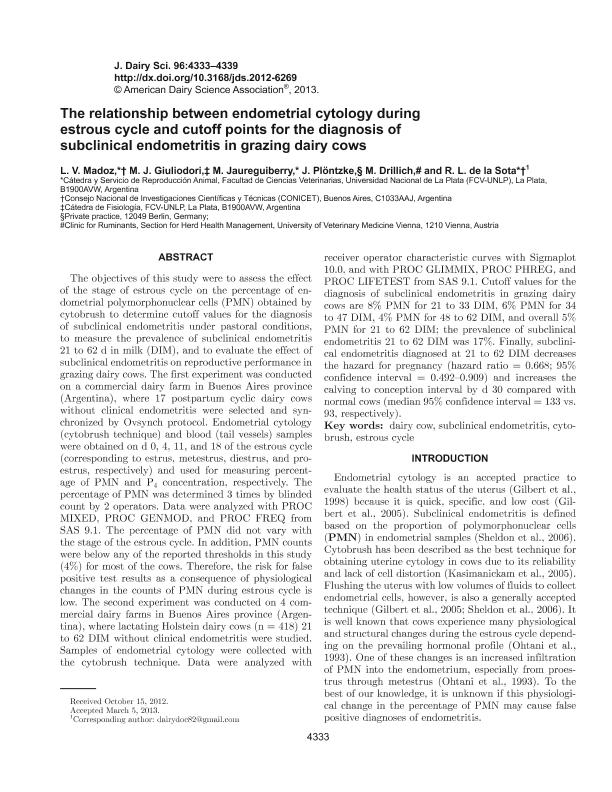Artículo
The relationship between endometrial cytology during estrous cycle and cutoff points for the diagnosis of subclinical endometritis in grazing dairy cows
Madoz, Laura Vanina ; Giuliodori, Mauricio Javier; Jaureguiberry, María
; Giuliodori, Mauricio Javier; Jaureguiberry, María ; Plöntzke, J.; Drillich, M.; de la Sota, Rodolfo Luzbel
; Plöntzke, J.; Drillich, M.; de la Sota, Rodolfo Luzbel
 ; Giuliodori, Mauricio Javier; Jaureguiberry, María
; Giuliodori, Mauricio Javier; Jaureguiberry, María ; Plöntzke, J.; Drillich, M.; de la Sota, Rodolfo Luzbel
; Plöntzke, J.; Drillich, M.; de la Sota, Rodolfo Luzbel
Fecha de publicación:
05/2013
Editorial:
Elsevier
Revista:
Journal of Dairy Science
ISSN:
0022-0302
Idioma:
Inglés
Tipo de recurso:
Artículo publicado
Clasificación temática:
Resumen
The objectives of this study were to assess the effect of the stage of estrous cycle on the percentage of endometrial polymorphonuclear cells (PMN) obtained by cytobrush to determine cutoff values for the diagnosis of subclinical endometritis under pastoral conditions, to measure the prevalence of subclinical endometritis 21 to 62 d in milk (DIM), and to evaluate the effect of subclinical endometritis on reproductive performance in grazing dairy cows. The first experiment was conducted on a commercial dairy farm in Buenos Aires province (Argentina), where 17 postpartum cyclic dairy cows without clinical endometritis were selected and synchronized by Ovsynch protocol. Endometrial cytology (cytobrush technique) and blood (tail vessels) samples were obtained on d 0, 4, 11, and 18 of the estrous cycle (corresponding to estrus, metestrus, diestrus, and proestrus, respectively) and used for measuring percentage of PMN and P4 concentration, respectively. The percentage of PMN was determined 3 times by blinded count by 2 operators. Data were analyzed with PROC MIXED, PROC GENMOD, and PROC FREQ from SAS 9.1. The percentage of PMN did not vary with the stage of the estrous cycle. In addition, PMN counts were below any of the reported thresholds in this study (4%) for most of the cows. Therefore, the risk for false positive test results as a consequence of physiological changes in the counts of PMN during estrous cycle is low. The second experiment was conducted on 4 commercial dairy farms in Buenos Aires province (Argentina), where lactating Holstein dairy cows (n = 418) 21 to 62 DIM without clinical endometritis were studied. Samples of endometrial cytology were collected with the cytobrush technique. Data were analyzed with receiver operator characteristic curves with Sigmaplot 10.0, and with PROC GLIMMIX, PROC PHREG, and PROC LIFETEST from SAS 9.1. Cutoff values for the diagnosis of subclinical endometritis in grazing dairy cows are 8% PMN for 21 to 33 DIM, 6% PMN for 34 to 47 DIM, 4% PMN for 48 to 62 DIM, and overall 5% PMN for 21 to 62 DIM; the prevalence of subclinical endometritis 21 to 62 DIM was 17%. Finally, subclinical endometritis diagnosed at 21 to 62 DIM decreases the hazard for pregnancy (hazard ratio = 0.668; 95% confidence interval = 0.492–0.909) and increases the calving to conception interval by d 30 compared with normal cows (median 95% confidence interval = 133 vs. 93, respectively).
Palabras clave:
Dairy Cow
,
Subclinical Endometritis
,
Cytobrush
,
Estrous Cycle
Archivos asociados
Licencia
Identificadores
Colecciones
Articulos(CCT - LA PLATA)
Articulos de CTRO.CIENTIFICO TECNOL.CONICET - LA PLATA
Articulos de CTRO.CIENTIFICO TECNOL.CONICET - LA PLATA
Citación
Madoz, Laura Vanina; Giuliodori, Mauricio Javier; Jaureguiberry, María; Plöntzke, J.; Drillich, M.; et al.; The relationship between endometrial cytology during estrous cycle and cutoff points for the diagnosis of subclinical endometritis in grazing dairy cows; Elsevier; Journal of Dairy Science; 96; 7; 5-2013; 4333-4339
Compartir
Altmétricas



